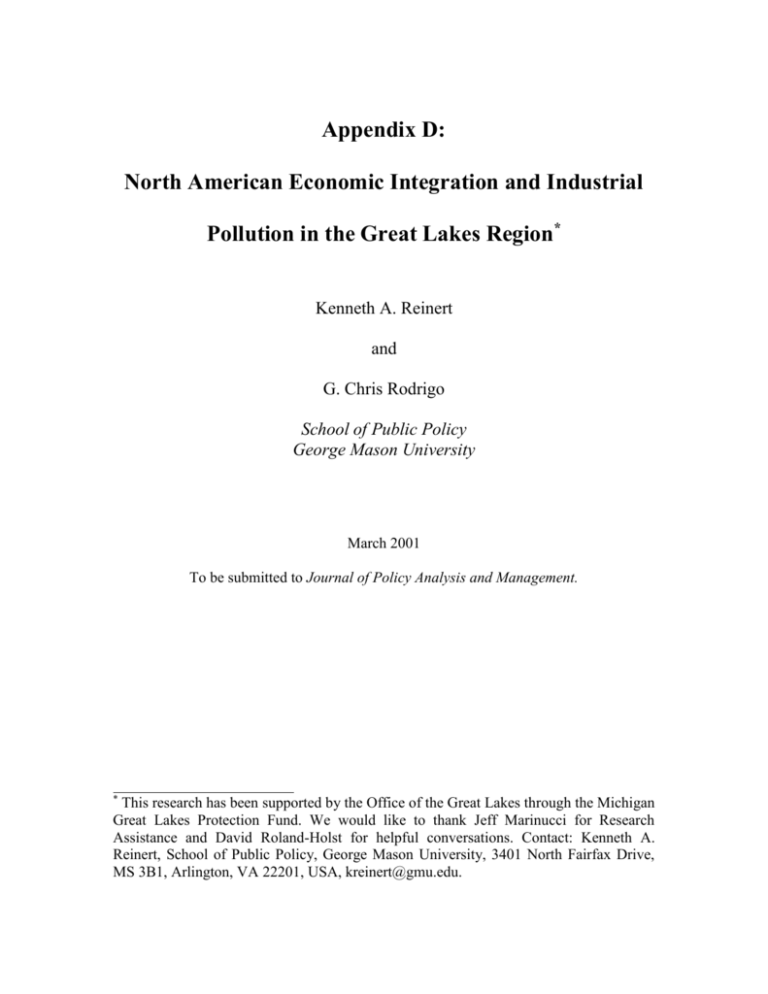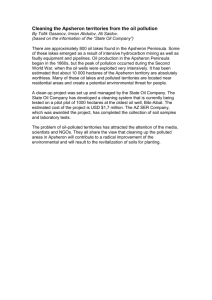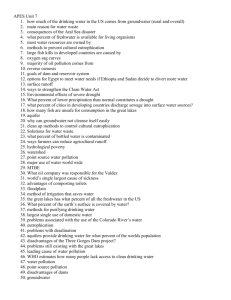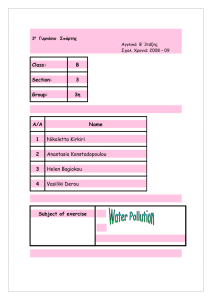The Industrial Pollution Consequences of North American Economic
advertisement

Appendix D: North American Economic Integration and Industrial Pollution in the Great Lakes Region* Kenneth A. Reinert and G. Chris Rodrigo School of Public Policy George Mason University March 2001 To be submitted to Journal of Policy Analysis and Management. * This research has been supported by the Office of the Great Lakes through the Michigan Great Lakes Protection Fund. We would like to thank Jeff Marinucci for Research Assistance and David Roland-Holst for helpful conversations. Contact: Kenneth A. Reinert, School of Public Policy, George Mason University, 3401 North Fairfax Drive, MS 3B1, Arlington, VA 22201, USA, kreinert@gmu.edu. North American Economic Integration and Industrial Pollution in the Great Lakes Region Abstract This paper provides an assessment of the impact of increased economic integration within North America on pollution intensities with the Great Lake states of the United States. We utilize a three-country, applied equilibrium model of the North American economy, data from the World Bank’s Industrial Pollution Projection System (IPPS), and employment data from the U.S. Bureau of Economic Analysis to simulate the industrial pollution impacts of North American economic integration within the Great Lakes region. The results reflect the liberalization of tariff and non-tariff barriers, their trade and production impacts, state-level shares in the production changes, and the resulting industrial effluent changes. In many cases, the Great Lake state account for a substantial portion of the total effluent changes caused by North American economic integration. INTRODUCTION The policy debates surrounding the negotiation, passage, and assessment of the North American Free Trade Area (NAFTA) have focused to a great extent on the linkages between trade and the environment. By necessity, these debates often take up regional issues. For example, much discussion has focused on the environmental impacts of NAFTA on the U.S.-Mexico border.1 However, as Nissan (1999) has shown, the Great Lake States of the United States have closer ties with Canada. Indeed, pollution concerns in the Great Lakes region are evident in the numerous pollution initiatives occurring on both sides of the U.S.-Canadian border. These include, but are not limited to, the Great Lakes Regional Pollution Prevention Roundtable, the Great Lakes Information Network, the Great Lakes Pollution Prevention Initiative, and the Binational Toxins Strategy. 2 In the case of industrial pollutions, the Great Lake states are particularly important since these comprise approximately one third of U.S. manufacturing output.3 1 For a definitive review, including the border issues, see Johnson and Beaulieu (1996). 2 See also Dworsky (1993) and Valiante, Muldoon, and Botts (1997). 3 See Allardice and Thorp (1995). 1 This paper provides an assessment of the impact of increased economic integration within North America on industrial pollution intensities with the Great Lake states of the United States. We utilize a three-country, applied equilibrium (AGE) model of the North American economy, data from the World Bank’s Industrial Pollution Projection System (IPPS), as well as employment data from the U.S. Bureau of Economic Analysis (BEA) simulate the industrial pollution impacts of North American economic integration within the Great Lakes region. The results reflect the liberalization of tariff and non-tariff barriers, their trade and production impacts, state-level shares in the production changes, and the resulting industrial effluent changes. MODELING APPROACH Our starting point is the Applied General Equilibrium (AGE) model of the North American economy developed by Reinert and Roland-Holst (1998) for the year 1991. Importantly, this is a full, three-country model, incorporating production, consumption and trade relationships in Canada, the United States, and Mexico. The AGE model is described in some detail in the appendix to this paper.4 The trade-liberalizing experiment we choose use observed tariff rates for our base year 1991. In addition, it uses very rough estimates of non-tariff barriers using UNCTAD data on trade control measures. As is general practice (e.g. Gaston and Trefler, 1994), we use NTB coverage ratios as ad valorem equivalents.5 We use the IPPS effluent data at the 3-digit level. These data have been aggregated to our sectoring scheme for each of the three countries individually using data from the United Nations Industrial Development Organization (UNIDO). As is recommended by their compilers, IPPS effluent data are utilized in their per-employee form. Table 1 describes the IPPS pollutants.6 In the case of air pollution, the IPPS data include particulates, carbon monoxide, sulfur dioxide, nitrogen dioxide, and volatile organic compounds. In the case of industrial bio-accumulative metals and toxins, the data 4 Readers not familiar with this style of economic modeling can consult Devarajan et al. (1997). A different modeling approach to the Great Lakes can be found in Lichty, McDonald, and Lampher (1996). 5 The NTB measures are detailed in Roland-Holst, Reinert, and Shiells (1994). 6 On the IPPS, see Hettige, Lucas and Wheeler (1992) and the references therein. 2 distinguish among transmission to air, water, and land. Finally, in the case of water pollution, the data distinguish between biological oxygen demand and total suspended solids. The result is a significant amount of detail in both sectoral and pollutant dimensions. In order to estimate the impacts of North American economic integration on industrial pollution within the Great Lakes states, we utilize state-level employment data for 1991 from the U.S. Bureau of Economic Analysis. We utilize employment shares by industry for Illinois, Indiana, Ohio, Michigan, Minnesota, New York, Pennsylvania, and Wisconsin. SIMULATIONS A great deal of results is generated in an exercise such as the one we have conducted. In order to make these results presentable, we consider each pollutant type and aggregate the results over the Great Lakes states.7 The pollutant types we consider are air pollution, bio-accumulative metals pollution, industrial toxin pollution, and water pollution. Table 2 presents the changes in industrial air pollution in the Great Lake states caused by trade liberalization in North America for each industrial sector of the Reinert/Roland-Holst model. In the case of particulates, the two most important contributors are the base metal and transportation equipment sectors.8 This is also the case for sulfur dioxide and volatile organic compounds. For carbon monoxide and nitrogen dioxide, the two most important contributors are the base metal and chemical sectors. The petroleum sector is also of note as a significant source of some air pollutants. In case of sulfur dioxide, the Great Lake states account for just short of one half of the additional U.S. emissions cause by North American economic integration. Table 3 presents the changes in industrial bio-accumulative metals pollution in the Great Lake states caused by trade liberalization in North America for each industrial sector of the Reinert/Roland-Holst model. For all three pollution types (metals to air, metals to water, and metals to land), the base metals sector is the most important source of emissions. For the case of metals to land, the chemicals, wood and metal products and 7 Country-level results can be found in Reinert and Roland-Holst (2001a). With regard to base metals, the Great Lakes states account for approximately 70 percent of total U.S. steel production. See Allardice and Thorp (1995). 8 3 transportation equipment sectors are also significant sources. For all three pollution types, the Great Lake states account for approximately one half of the additional U.S. emissions caused by North American economic integration. Table 4 presents the changes in industrial toxin pollution in the Great Lake states caused by trade liberalization in North America for each industrial sector of the Reinert/Roland-Holst model. Except for the case of toxins to water, where the transportation equipment sector is not important, the chemicals, base metals, and transportation equipment sectors are the most significant sources of toxin pollution accumulating to air, water, and land. For toxin pollution, the Great Lake states are less important in contributing to U.S. totals than for air and bio-accumulative metals. Table 5 presents the changes in industrial water pollution in the Great Lake states caused by trade liberalization in North America for each industrial sector of the Reinert/Roland-Holst model.9 Once again, the base metals sector appears as a significant source of emissions. In the case of biological oxygen demand, the food processing sector is also a significant source of emissions, and in the case of total suspended solids, so does the chemicals sector. The case of total suspended solids is very notable here in that the Great Lake states contribute approximately 60 percent of the U.S. total. This type of water pollution would appear to be of major concern to the Great Lakes ecosystem. Finally, Tables 6 through 9 provide results equivalent to Tables 2 through 5 for the state of Michigan. For comparison purposes, the Great Lakes totals from Tables 2 through 5 are listed at the bottom of each of these Michigan tables. CONCLUSIONS The Great Lakes are positioned on the border of two countries in the process of increased economic integration. Given the fragile nature of these water resources, there has been a great deal of concern about the linkage in the Great Lakes region between increased economic activity and environmental degradation. In the case of industrial pollutions, the “The Great Lakes region’s abundant water supply is an important resource connection for industry. Water use in manufacturing operations is concentrated in five major sectors: steel production, food processing, petroleum refining, chemicals/allied products and paper—all of which are well-represented in the regional economy. This intensity of water use is illustrated by the fact that the Great Lakes states account for 40% of U.S. industrial water use, and much of this demand is based in the Basin” (Allardice and Thorp, 1995). 9 4 Great Lake states are particularly important since these comprise approximately one third of U.S. manufacturing output. Indeed, as demonstrated by the results presented in Tables 2 through 5, the Great Lake states account for a substantial portion of the total industrial pollution generated by increased integration of the North American economies. These effects are concentrated in the chemical, base metal, wood and metal product, and transportation equipment sectors. For specific pollutants, the petroleum and food processing sectors are also important sources. 5 REFERENCES Allardice, D. R., & S. Thorp, S. (1995). A changing Great Lakes economy: Economic and environmental linkages. SOLEC Working Paper presented at State of the Lakes Ecosystem Conference, http://www.epa.gov/grtlakes/solec/94/economic. Devarajan, S., Go, D.S., Lewis, J.D., Robinson, S., & Sinko, P. (1997). Simple general equilibrium modeling. In J. Francois & K. Reinert (Eds.), Applied methods for trade policy modeling: A handbook (Chapter 6, pp. 156-185). Cambridge: Cambridge University Press. Dworsky, L.B. (1993). Ecosystem management: Great Lakes perspectives. Natural Resource Journal, 33, 347-362. Gaston, N., & Trefler, D. 1994. Protection, trade, and wages: Evidence from US manufacturing. Industrial and Labor Relations Review, 47, 574-593. Hettige, H., Lucas, R.E.B, & Wheeler, D. 1992. The toxic intensity of industrial production: Global patterns, trends, and trade policy. American Economic Review, 82, 478-481. Johnson, P.M. and Beaulieu, A. (1996). The environment and NAFTA. Washingtion DC: Island Press. Lichty, R.W., McDonald, M.E., & Lamphear, C.F. (1996). An economic/environmental assessment model for the Great Lakes: GLEAM. Journal of Regional Analysis and Policy, 26, 3-15. de Melo, J., & Robinson, S. 1989. Product differentiation and the treatment of foreign trade in computable general equilibrium models of small economies. Journal of International Economics, 27, 47-67. Nissan, E. (1999). Regional Industrial Trade with Canada and Mexico. Journal of Regional Analysis and Public Policy, 29, 20-31. Reinert, K.A., & Roland-Holst, D.W. (2001a). NAFTA and industrial pollution: Some general equilibrium estimates. Journal of Economic Integration, 16:2, in press. Reinert, K.A., & Roland-Holst, D.W. (2001b). Industrial pollution linkages in North America: A linear analysis. Economic Systems Research, 13:2, in press. Reinert, K.A., & Roland-Holst, D.W. 1998. North-South trade and occupational wages: Some evidence from North America. Review of International Economics, 6, 74-89. 6 Roland-Holst, D.W., Reinert, K.A., & Shiells, C.R. (1994). NAFTA Liberalization and the role of nontariff barriers. North American Journal of Economics and Finance, 5, 137168. Valiante, M., Muldoon, P., and Botts, L. (1997). Ecosystem governance: Lessons from the Great Lakes. In O.R. Young (Ed.), Global governance: Drawing insights from the environmental experience (Chapter __, pp. 197-225). Cambridge: MIT Press. APPENDIX: AGE MODEL STRUCTURE The AGE model used to simulate the industrial pollution effects of North American trade liberalization is a three-country, 26-sector model calibrated to a 1991 social accounting matrix. The construction of this social accounting matrix is described in Reinert and Roland-Holst (2001b). The trade specification follows that of de Melo and Robinson (1989). In each sector of each country, domestic demand is constituted of goods that are differentiated by origin (domestic good, imports from each North American trading partner, and imports from the rest of the world) and destination (domestic good, exports to each North American trading partner, and exports to the rest of the world). With regard to each country’s relationship to the rest of the world, we maintain the small-country assumption of fixed world prices. Exchange rates are flexible, while trade balances are fixed. Production in each sector of each country utilizes physical capital and labor. These factors are assumed to be perfectly mobile among the sectors of each country but immobile among countries. Production takes place under constant returns to scale using constant elasticity of substitution (CES) functional forms for value added and Leontief (fixed coefficient) intermediates. Final demand in each country is modeled using the linear expenditure (LES) functional form. All markets are perfectly competitive. The calibration of the model also requires a set of behavior parameters. These include elasticities of substitution between labor and capital, elasticities of substitution among imports and domestic goods, and elasticities of transformation among exports and domestic supply. Sources for these elasticities can be found in Reinert and Roland-Holst (2001a). 7 Table 1. The IPPS Pollutants Name Particulates Carbon Monoxide Symbol PT CO Sulfur Dioxide SO2 Nitrogen Dioxide NO2 Volatile Organic Compounds VOC Bio-accumulative Metals MetAir, MetWat, MetLand Toxic Pollutants ToxAir, ToxWat, ToxLand Biological Oxygen Demand BOD Total Suspended Solids TSS Source: World Bank Industrial Pollution Projection System 8 Description Fine airborne particles that can damage respiratory systems. A poisonous gas that inhibits the ability of blood to carry oxygen. A gas that can contribute to respiratory disease and acid rain. A gas that contributes to both respiratory disease and to the formation of acid rain and ozone. A class of chemicals associated with skin reactions, nervous system effects, sick-building syndrome, and multiple chemical sensitivity. Many are also suspected carcinogens. Metals, including mercury, lead, arsenic, chromium, nickel, copper, zinc, and cadmium. They contribute to mental and physical birth defects. A class of chemicals that can damage internal organs and neurological functions, cause reproductive problems and birth defects. Many are also suspected carcinogens. Organic water pollutants that remove dissolved oxygen. They can damage aquatic species and promote the growth of algae and pathogens. Non-organic, non-toxic particles that can damage aquatic ecosystems and promote the growth of pathogens. Table 2. North American Integration and Industrial Air Pollution in the Great Lake States (thousands of pounds) Sector PT CO SO2 NO2 VOC petrol 279 1,104 2,153 1,252 1,027 foodpr 681 214 1,008 905 451 textl 14 13 68 89 41 cloth 0 0 -1 0 0 leath 38 5 70 17 124 paper 7 42 37 20 10 chem. 400 3,919 2,068 1,975 1,700 rubber 29 10 235 79 436 nmtmn -71 -13 -98 -65 -5 bsmetl 6,682 41,965 47,883 8,797 3,498 wdmetl 719 1,591 322 699 1,748 nelcmc 31 226 209 94 238 elcmc -3 -18 -32 -16 -21 trnseq 1,279 2,177 3,096 1,609 11,563 othmn 0 0 0 0 2 great lakes total 10,086 51,236 57,018 15,458 20,811 us total 24,349 103,913 127,442 35,750 55,991 Sectors are: petroleum; food processing;; textiles; clothing; leather; paper; chemicals; rubber; non-metalic mineral products; base metals; wood and metal products; non-electrical machinery; electrical machinery; transportation equipment; and other manufactures. Pollutants are: PT- particulates; CO- carbon monoxide; SO2- sulfur dioxide; NO2- nitrogen dioxide; VOC- volatile organic compounds. 9 Table 3.North American Integration and Industrial Bio-accumulative Metals Pollution in the Great Lakes States (thousands of pounds) Sector MetAir MetWat MetLand petrol 1 0 7 foodpr 0 0 3 textl 0 0 2 cloth 0 0 0 leath 0 0 41 paper 0 0 0 chem. 4 4 128 rubber 1 0 28 nmtmn 0 0 0 bsmetl 330 29 9,053 wdmetl 5 1 143 nelcmc 2 0 41 elcmc 0 0 -7 trnseq 37 1 447 othmn 0 0 0 great lakes total 379 35 9,887 us total 776 65 20,765 Sectors are: petroleum; food processing;; textiles; clothing; leather; paper; chemicals; rubber; non-metalic mineral products; base metals; wood and metal products; non-electrical machinery; electrical machinery; transportation equipment; and other manufactures. Pollutants are: Metals to air, water, and land. 10 Table 4. North American Integration and Industrial Toxin Pollution in the Great Lakes States (thousands of pounds) Sector ToxAir ToxWat ToxLand petrol 95 7 378 foodpr 49 10 120 textl 28 5 17 cloth 0 0 0 leath 171 6 308 paper 9 2 3 chem. 1,284 370 2,911 rubber 637 2 206 nmtmn -3 0 -4 bsmetl 3,303 443 11,816 wdmetl 635 22 491 nelcmc 152 4 101 elcmc -30 0 -30 trnseq 6,210 24 2,679 othmn 5 0 2 great lakes total 12,544 893 18,998 us total 32,920 2,261 44,826 Sectors are: petroleum; food processing;; textiles; clothing; leather; paper; chemicals; rubber; non-metalic mineral products; base metals; wood and metal products; non-electrical machinery; electrical machinery; transportation equipment; and other manufactures. Pollutants are: Toxins to air, water, and land. 11 Table 5. North American Integration and Industrial Water Pollution in the Great Lakes States (thousands of pounds) Sector BOD TSS petrol 23 116 foodpr 1,089 427 textl 3 4 cloth 0 0 leath 30 61 paper 20 67 chem. 470 1,734 rubber 154 124 nmtmn 0 -2 bsmetl 2,304 229,424 wdmetl 24 274 nelcmc 1 17 elcmc -1 -2 trnseq 5 40 othmn 0 40 great lakes total 4,122 232,325 us total 11,615 385,891 Sectors are: petroleum; food processing;; textiles; clothing; leather; paper; chemicals; rubber; non-metalic mineral products; base metals; wood and metal products; non-electrical machinery; electrical machinery; transportation equipment; and other manufactures. Pollutants are: BOD- biological oxygen demand; and TSS- total suspended solids. 12 Table 6. North American Integration and Industrial Air Pollution in Michigan (thousands of pounds) Sector PT CO SO2 NO2 VOC petrol 15 58 113 66 54 foodpr 59 19 88 79 39 textl 0 0 0 0 0 cloth 0 0 0 0 0 leath 3 0 5 1 9 paper 1 3 3 2 1 chem. 51 503 265 253 218 rubber 4 1 33 11 60 nmtmn -7 -1 -9 -6 0 bsmetl 656 4,119 4,700 863 343 wdmetl 124 275 56 121 302 nelcmc 4 31 29 13 32 elcmc 0 -1 -2 -1 -1 trnseq 518 882 1,255 652 4,686 othmn 0 0 0 0 0 michigan total 1,428 5,889 6,535 2,054 5,744 great lakes total 10,086 51,236 57,018 15,458 20,811 Sectors are: petroleum; food processing;; textiles; clothing; leather; paper; chemicals; rubber; non-metalic mineral products; base metals; wood and metal products; non-electrical machinery; electrical machinery; transportation equipment; and other manufactures. Pollutants are: PT- particulates; CO- carbon monoxide; SO2- sulfur dioxide; NO2- nitrogen dioxide; VOC- volatile organic compounds. 13 Table 7.North American Integration and Industrial Bio-accumulative Metals Pollution in Michigan (thousands of pounds) Sector MetAir MetWat MetLand petrol 0 0 0 foodpr 0 0 0 textl 0 0 0 cloth 0 0 0 leath 0 0 3 paper 0 0 0 chem. 0 0 16 rubber 0 0 4 nmtmn 0 0 0 bsmetl 32 3 889 wdmetl 1 0 25 nelcmc 0 0 6 elcmc 0 0 0 trnseq 15 0 181 othmn 0 0 0 michigan total 49 4 1,124 great lakes total 379 35 9,887 Sectors are: petroleum; food processing;; textiles; clothing; leather; paper; chemicals; rubber; non-metalic mineral products; base metals; wood and metal products; non-electrical machinery; electrical machinery; transportation equipment; and other manufactures. Pollutants are: Metals to air, water, and land. 14 Table 8. North American Integration and Industrial Toxin Pollution in Michigan (thousands of pounds) Sector ToxAir ToxWat ToxLand petrol 5 0 20 foodpr 4 1 10 textl 0 0 0 cloth 0 0 0 leath 12 0 22 paper 1 0 0 chem. 165 47 373 rubber 88 0 28 nmtmn 0 0 0 bsmetl 324 43 1,160 wdmetl 110 4 85 nelcmc 21 1 14 elcmc -2 0 -2 trnseq 2,517 10 1,086 othmn 0 0 0 michigan total 3,245 107 2,797 great lakes total 12,544 893 18,998 Sectors are: petroleum; food processing;; textiles; clothing; leather; paper; chemicals; rubber; non-metalic mineral products; base metals; wood and metal products; non-electrical machinery; electrical machinery; transportation equipment; and other manufactures. Pollutants are: Toxins to air, water, and land. 15 Table 9. North American Integration and Industrial Water Pollution in Michigan (thousands of pounds) Sector BOD TSS petrol 1 6 foodpr 95 37 textl 0 0 cloth 0 0 leath 2 4 paper 2 5 chem. 60 222 rubber 21 17 nmtmn 0 0 bsmetl 226 22,518 wdmetl 4 47 nelcmc 0 2 elcmc 0 0 trnseq 2 16 othmn 0 2 michigan total 414 22,878 great lakes total 4,122 232,325 Sectors are: petroleum; food processing;; textiles; clothing; leather; paper; chemicals; rubber; non-metalic mineral products; base metals; wood and metal products; non-electrical machinery; electrical machinery; transportation equipment; and other manufactures. Pollutants are: BOD- biological oxygen demand; and TSS- total suspended solids. 16







